What is the full form of ICICI Bank? – ICICI Full Form
An Overview of ICICI Bank. ICICI acronym stands for Industrial Credit and Investment Corporation of India. It was established in 1955 at the initiative of the World Bank, the Government of India, and representatives of Indian industry. The principal objective was to create a development financial institution for providing project financing to Indian businesses. 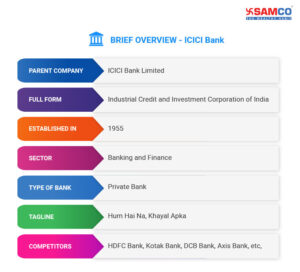
ICICI Bank's Timeline History:
ICICI Bank's Shareholding Pattern:
| Mar-18 | Mar-19 | Mar-20 | Mar-21 | |
| FIIs | 48.1 | 43.05 | 43.73 | 47.81 |
| DIIs | 41.56 | 45.41 | 44.58 | 41.7 |
| Government | 0.22 | 0.33 | 0.39 | 0.43 |
| Public | 10.12 | 11.21 | 11.31 | 10.06 |
Products and Service Offered by ICICI Bank -
ICICI bank offers the following products and services - 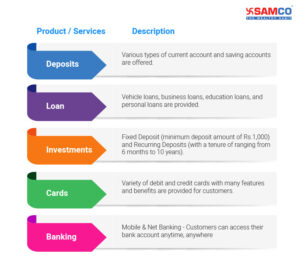
ICICI Bank's Important Financial Details:
| Particulars | As of 2020 |
| Revenue | ₹1,49,786.10 crore |
| Operating Income | ₹78,268.2 crore |
| Net Income | ₹9,566.31 crore |
| Net Assets | ₹13,77,292.23 crore |
| Total Equity | ₹1,18,518.45 crore |
Ratio Analysis of ICICI Bank -
1. Basic Earnings Per Share (EPS) Formula: Basic EPS = (Net Income – Preferred Dividend) /Number of Common Shares Outstanding It indicates how much money a company makes for each outstanding share. Companies with higher EPS are considered to be more profitable. This is readily available in the Income Statement of every listed company. Let's have a look at ICICI Bank's past 5 years EPS trend -
| Years | March 16 | March 17 | March 18 | March 19 | March 20 |
| EPS | 17.53 | 15.91 | 12.02 | 6.61 | 14.81 |
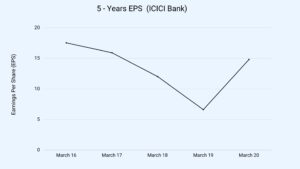
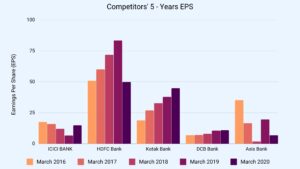
| Years | March 16 | March 17 | March 18 | March 19 | March 20 |
| NP Margin | 18.42 | 18.60 | 14.63 | 7.90 | 13.23 |
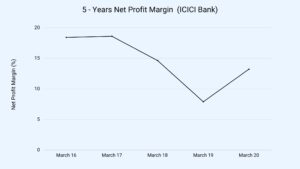
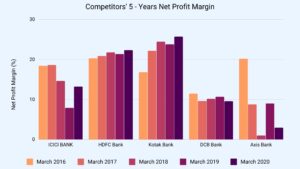
| Years | March 16 | March 17 | March 18 | March 19 | March 20 |
| ROCE | 3.46 | 3.75 | 3.10 | 2.39 | 2.60 |
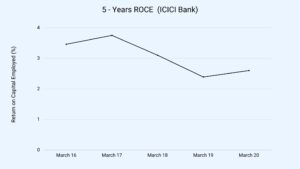
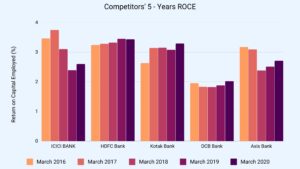
| Years | March 16 | March 17 | March 18 | March 19 | March 20 |
| NIM | 2.75 | 2.64 | 2.48 | 2.64 | 2.91 |
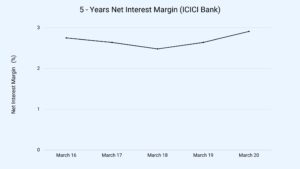
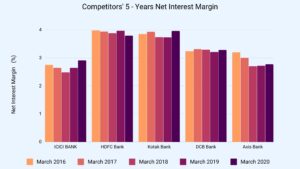
| Years | March 16 | March 17 | March 18 | Mach 19 | March 20 |
| NPA % | 2.67 | 4.89 | 4.77 | 2.06 | 1.41 |
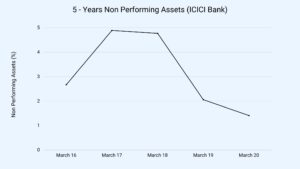
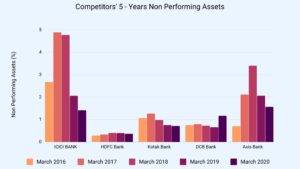
| Years | March 16 | March 17 | March 18 | March 19 | March 20 |
| ROA | 1.10 | 1.03 | 0.68 | 0.34 | 0.69 |
It measures how efficiently a company can convert the money used to buy an asset into profits. This ratio measures a bank’s ability to generate returns from the deposits it receives. ROA is extremely important while analysing banks. Here is ICICI Bank's five-year ROA trend – 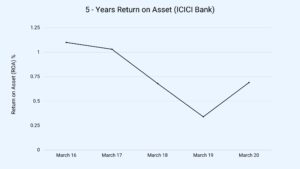
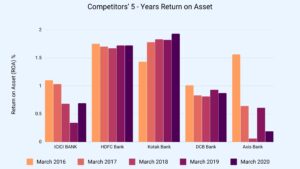
ICICI Bank’s Subsidiaries:
ICICI Bank's Key Personnel:
Mutual Fund holdings and trends of ICICI Bank Ltd:
| Schemes | Quantity as of March 2021 |
| KOTAK FLEXICAP FUND - GROWTH | 261,945 |
| ICICI PRUDENTIAL BLUECHIP FUND - GROWTH | 231,718 |
| HDFC BALANCE ADVANTAGE FUND - REGULAR PLAN - GROWTH | 199,574 |
| MIRAE ASSET LARGE CAP FUND - REGULAR - GROWTH | 191,069 |
| HDFC FLEXICAP FUND - GROWTH OPTION | 182,537 |
| ICICI PRUDENTIAL BALANCED ADVANTAGE FUND - GROWTH | 178,707 |
| SBI BLUE CHIP FUND - GROWTH | 177,210 |
| ADITYA BIRLA SUN LIFE FRONTLINE EQUITY FUND - GROWTH | 172,488 |
| AXIS BLUECHIP FUND - REGULAR GROWTH | 154,373 |
| HDFC HYBRID EQUITY FUND - REGULAR PLAN - GROWTH | 131,596 |
Visit ICICI's House Group Page and their valuation pages by SAMCO:
Listed stocks:
SAMCO’s Valuation Analysis for ICICI Bank –
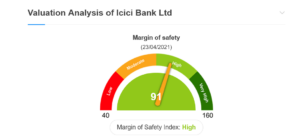

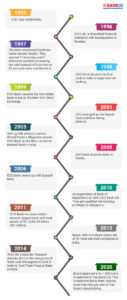
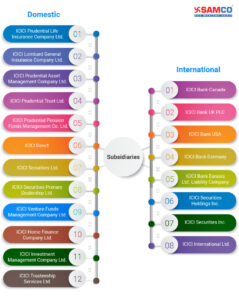
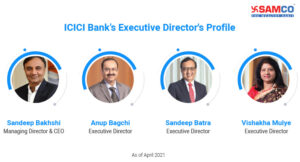


 Easy & quick
Easy & quick
Leave A Comment?